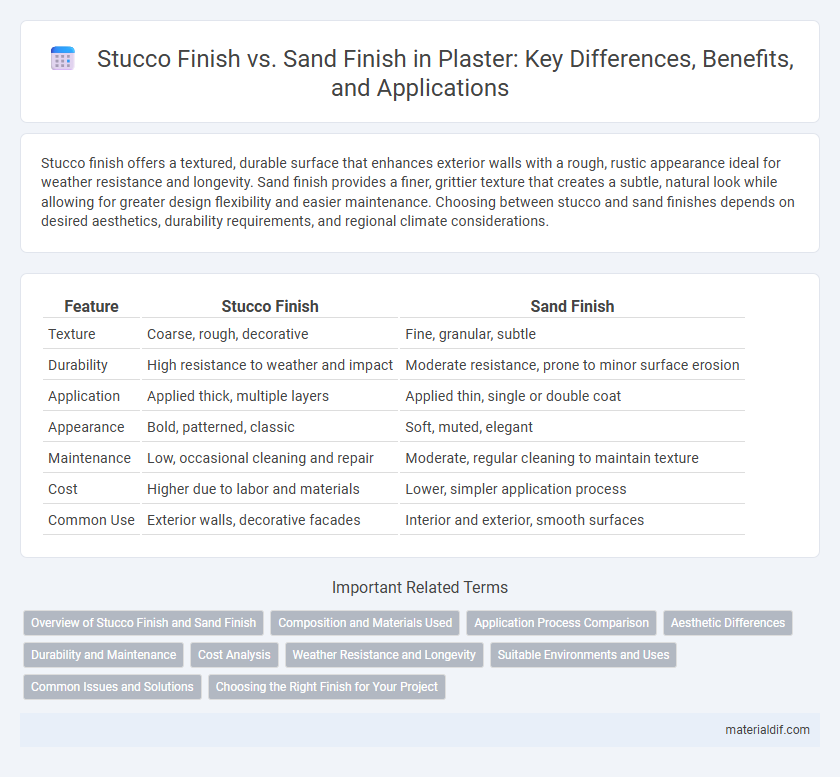Stucco finish offers a textured, durable surface that enhances exterior walls with a rough, rustic appearance ideal for weather resistance and longevity. Sand finish provides a finer, grittier texture that creates a subtle, natural look while allowing for greater design flexibility and easier maintenance. Choosing between stucco and sand finishes depends on desired aesthetics, durability requirements, and regional climate considerations.
Table of Comparison
| Feature | Stucco Finish | Sand Finish |
|---|---|---|
| Texture | Coarse, rough, decorative | Fine, granular, subtle |
| Durability | High resistance to weather and impact | Moderate resistance, prone to minor surface erosion |
| Application | Applied thick, multiple layers | Applied thin, single or double coat |
| Appearance | Bold, patterned, classic | Soft, muted, elegant |
| Maintenance | Low, occasional cleaning and repair | Moderate, regular cleaning to maintain texture |
| Cost | Higher due to labor and materials | Lower, simpler application process |
| Common Use | Exterior walls, decorative facades | Interior and exterior, smooth surfaces |
Overview of Stucco Finish and Sand Finish
Stucco finish is a textured plaster coating known for its durability, weather resistance, and ability to create a variety of decorative effects on exterior walls. Sand finish, a subtype of stucco, incorporates coarse sand particles to produce a rough, gritty surface with enhanced slip resistance and a natural, earthy appearance. Both finishes serve functional and aesthetic purposes but differ primarily in texture and grip, making stucco finish ideal for smooth or patterned designs and sand finish suitable for non-slip outdoor applications.
Composition and Materials Used
Stucco finish primarily consists of cement, sand, lime, and water, creating a dense, durable surface ideal for exterior walls. Sand finish incorporates a higher quantity of coarse sand, producing a rougher texture with enhanced grip and weather resistance. Both finishes use similar base materials, but variations in sand grain size and lime content significantly affect the final appearance and durability.
Application Process Comparison
Stucco finish involves applying multiple coats of plaster with a trowel to create a dense, textured surface, requiring precise timing between layers for proper curing. Sand finish uses a single plaster coat mixed with sand particles, applied with a float to achieve a rougher, grainy texture and allows for quicker application. Both techniques demand skilled labor, but the stucco finish process is more labor-intensive and time-consuming due to its layering and drying stages.
Aesthetic Differences
Stucco finish provides a smooth, refined surface with subtle texture variations, ideal for sleek, modern architectural designs, while sand finish features a coarse, granular texture that creates a rustic, tactile appearance suited for traditional or Mediterranean styles. The interplay of light on a stucco finish results in soft, shadowed highlights, whereas the sand finish's roughness enhances visual depth through pronounced shadows. Choosing between these finishes depends on the desired aesthetic impact and the architectural context of the plastered surface.
Durability and Maintenance
Stucco finish offers superior durability due to its dense, cement-based composition that resists cracking and weathering better than sand finish, which has a coarser texture and is more prone to erosion over time. Maintenance for stucco finish is typically lower, requiring only occasional cleaning and minor repairs, whereas sand finish demands more frequent upkeep to address chipping and surface wear. Choosing stucco finish enhances long-term structural integrity and reduces repair costs, making it ideal for exterior walls exposed to harsh environmental conditions.
Cost Analysis
Stucco finish typically costs between $6 to $9 per square foot, offering a more durable and decorative surface ideal for exterior walls. Sand finish is generally less expensive, ranging from $4 to $7 per square foot, providing a textured but simpler appearance suitable for budget-conscious projects. Comparing these options, the stucco finish demands higher material and labor expenses but delivers enhanced longevity and aesthetic appeal.
Weather Resistance and Longevity
Stucco finish offers superior weather resistance compared to sand finish due to its denser, more uniform surface that effectively repels water and resists cracking caused by temperature fluctuations. The tightly bonded cementitious materials in stucco provide enhanced durability and longevity, making it ideal for harsh climates with frequent moisture exposure. Sand finish, while aesthetically appealing with its textured appearance, tends to absorb moisture more readily and may require more frequent maintenance to prevent deterioration over time.
Suitable Environments and Uses
Stucco finish is ideal for exterior walls in dry, warm climates due to its durability and resistance to weathering, making it suitable for Mediterranean, Southwestern, and modern architectural styles. Sand finish, with its gritty texture, excels in both interior and exterior applications where a more rustic look is desired, commonly used in historic renovations and residential facades. Both finishes offer breathable barriers, but stucco's dense composition suits areas with minimal moisture, while sand finish provides more texture for slip-resistant surfaces in moderate climates.
Common Issues and Solutions
Stucco finish often faces cracking and efflorescence due to moisture penetration, which can be mitigated with proper waterproofing and flexible mesh reinforcement. Sand finish commonly shows surface erosion and discoloration caused by weather exposure, requiring regular sealing and gentle cleaning to maintain its texture and color. Both finishes benefit from routine inspections and timely repairs to prevent long-term structural damage and preserve aesthetic appeal.
Choosing the Right Finish for Your Project
Stucco finish offers a textured, decorative surface ideal for exterior walls, providing durability and weather resistance, making it suitable for architectural detailing. Sand finish delivers a uniform, grainy texture that enhances slip resistance and works well for exterior surfaces requiring subtle aesthetics and strong adhesion. Selecting the right finish depends on factors like climate exposure, desired appearance, and surface functionality, ensuring optimal performance and longevity for your plaster project.
Stucco Finish vs Sand Finish Infographic

 materialdif.com
materialdif.com